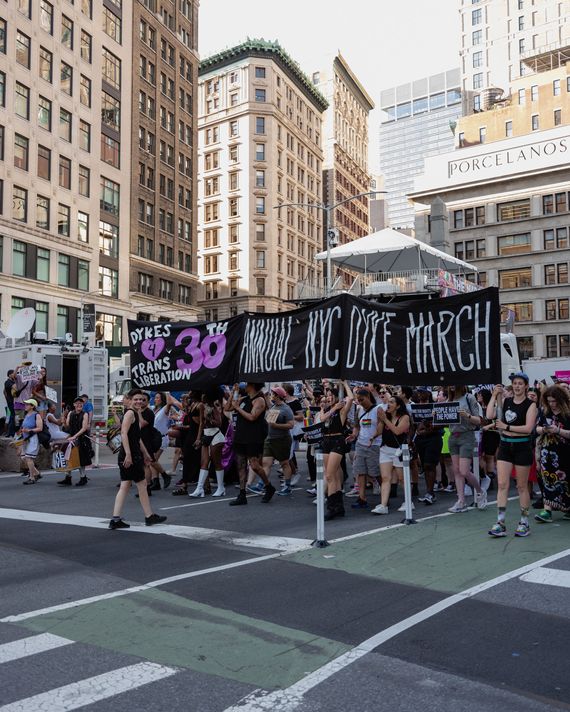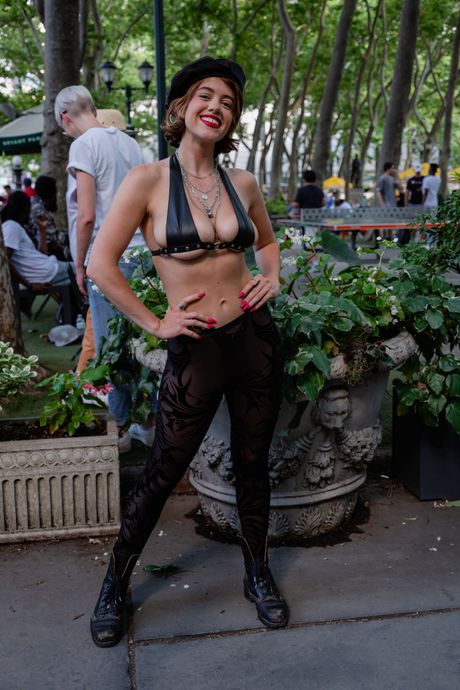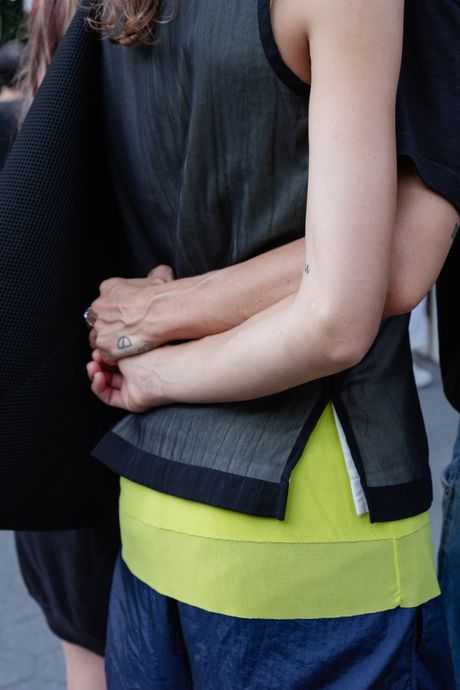
In June 1993, a crowd of an estimated 700 people — all of whom were there thanks to club cards passed out in the community — marched down Sixth Avenue in what was then known as the First New York Annual Dyke Pride March. Festive dancers gyrated on a giant bed that was pushed through the protest on theater-equipped wheels. Organized without a permit, it was stopped at 34th Street by NYPD officers, who warned them not to enter Macy’s.
Just two years later, the throng of self-identified dykes had grown to an estimated 20,000. They trudged down Fifth Avenue, from Bryant Park all the way south to Washington Square Park, this time despite the stern warning of then-Mayor Rudy Giuliani that anyone going nude at any of the city’s annual Pride celebrations would be arrested. One volunteer, Alexis Danzig, passed out homemade leaflets: “Women know your rights: You can be topless in NYC. Support your sisters.”
Maxine Wolfe, a member of the Lesbian Avengers, the organizing grassroots group, was standing near the front. As the crowd headed onto 23rd Street, filling Fifth Avenue back up to 42nd Street, a whisper passed through it. “We took off our T-shirts and swung them over our head,” the now 81-year-old Wolfe recalls. “It was like a wave. There were thousands of us marching downtown that way. That really showed the power of people doing something together. This was a collective community saying, ‘You can’t tell us what to do with our bodies.’” In the end, no one got arrested. Wolfe has attended nearly every Dyke March in its 30-year history as a volunteer marshal helping to usher the crowds to the park, where folks linger for hours, dancing, celebrating, splashing in the fountain, and just luxuriating in a sustained lesbian-and-queer social space of the kind that’s all too rare in the city.
The Dyke March, along with the bars Henrietta Hudson (founded in 1991) and Cubbyhole (1994), is one of the few Manhattan lesbian heirlooms still around. Its first iteration took place in April 1993, the day before the LGBT March on Washington ushered 20,000 lesbians from DuPont Circle to the White House. The march’s grassroots success inspired New York’s Lesbian Avengers to re-create the event before NYC’s Pride Rally. Now, the banner Wolfe painted for the first march is reused every year, stored by a volunteer and half-repainted to encompass the annual theme. This year’s was D4T — Dykes for Trans Liberation.


“We came back from D.C. with our head in the clouds,” recalls Marlene Colburn, 69. She and the Lesbian Avengers, who ranged from college students to senior citizens, would meet at a loft on Avenue D, planning actions throughout the city. “We could be serious, but we could also have fun. That was our legacy,” Colburn says. “Our actions were direct but had a sense of humor in them.”
Wolfe and Colburne have witnessed the march evolve while continuing the Avengers’ legacy of taking to the streets. Now, annual appearances include marching-band tunes by Big Apple Corps, pulsating beats from drumming groups, the welcome revving of the Sirens Women’s Motorcyle Club, and the Church Ladies for Choice, who serenade marchers: “God is a lesbian, God is a dyke.” One thing hasn’t changed: Dyke March has no corporate sponsors, no official city permits, and runs entirely through volunteers and small fundraising efforts. The entire budget for the event is less than $7,000 — and usually some of that is donated to the year’s cause of choice.
“I’m consistently surprised we can do this every year. A lot of magic has to happen,” committee member Francesa Capossela tells me. “When we get to Washington Square Park, I feel like every bit of me has been in service of something,” she says. “I’m a dyke, and I’m proud.”
Over the weekend, another estimated 20,000 self-identifying dykes marched down Fifth Avenue on the scorchingly sunny Saturday that marked the event’s 30th anniversary. The street swelled with marchers singing “When the Dykes Go Marching in,” echoing familiar social-justice protest chants like “Hey Ho, Homophobia’s got to go” and denouncing Friday’s Supreme Court ruling: “Fuck! The Sco! Tus!” Participants spun each other and shimmied through spontaneous dance circles forming in the streets, dancing to the beat of an all-dyke drum group, which paused playing only once, for a moment of silence at 23rd Street. Marshals locked hands at cross streets to stop traffic; other volunteers passed out cold water, fresh strawberries, and PPE and weren’t shy to offer a loud “Let’s Go Lesbians” to keep the crowd on pace. Tops flew off yet again — not for voyeurism, but in celebration.